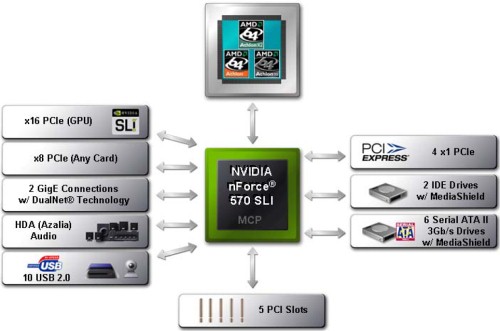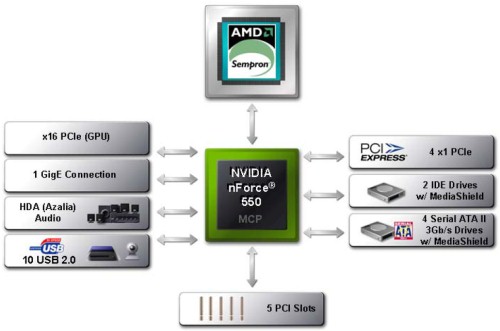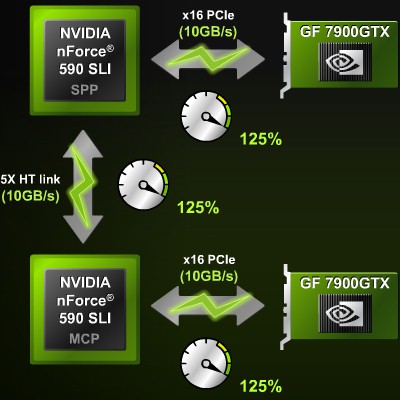 |
||
|
||
| ||
Let's put it straight, NVIDIA didn't have to launch a new series of chipsets: there are no plans on upgrading to a new standard of a system or peripheral bus so far. AMD has actually designed processors with DDR2 support. But memory operations in the AMD64 architecture are private affairs of a processor, it does not require any support from a chipset. However, an excellent occasion to nForce 500 (instead of the expected nForce5) was an announcement of a new socket of AMD Athlon 64/FX/X2 models (let's not forget about Sempron) — Socket AM2. Of course, motherboards can combine well an nForce 500 chipset with old Socket 939 or, vice versa, VIA K8T800 (ok, K8T890) with Socket AM2. But it seems to me that the new chipsets will mostly be used for the new socket.
So, let's have a look at what NVIDIA offers as an nForce4 replacement. It's a replacement, no doubt: 4 models of the new family coincide with 4 models of the nForce4 family [expanded by nForce4 SLI X16]; even the chipset names are practically unchanged. At the same time, there are no integrated chipsets among the new models. This NVIDIA's flank is still covered by GeForce 6100/6150. The top model in this series is nForce 590 SLI. nForce 590 SLITop product must have top positioning. NVIDIA even prepared a new memory standard (EPP, we'll talk about it later) specially for nForce 590 SLI, as it's nicely put in press-releases of the company. At least we have no information yet that motherboards on another nForce 500 chipset will support memory with EPP (so called "SLI-Ready"). Other features of nForce 590 SLI include an enhanced overclocking potential (including automatic LinkBoost) and full-speed SLI mode (x16+x16), a certain sign that this chipset is an heir to nForce4 SLI X16. Indeed, like nForce4 SLI X16, nForce 590 SLI is the only model in the new family, which is a true chipset (a set of [two] chips-bridges). Functionality is also divided between the bridges in a similar way.  Northbridge (SPP) is responsible only for one PCI Express x16 slot and connects a processor (+memory) with Southbridge. Southbridge (MCP) offers nearly complete functionality of a modern chipset, adding a couple of new features. Here is a summary of their features:
nForce 590 SLI has an obvious advantage over its nForce4 counterpart - HDA support (instead of AC’97) and the second gigabit network interface. The improvement is not only quantitative, but qualitative as well (read about the advantages of DualNet below). NVIDIA chipsets have been a consolation to PATA fans only for a short time: the first generation of the PCI Express era used to support four such devices, but now the company has preserved only one ATA133 channel - and this company sets AMD trends (like Intel in terms of Intel chipsets). On one hand, it's timely — even though SATA drives are not faster so far (on the average), they are more convenient to use and are much more popular among retailers. Two connectors should be enough for optical storage devices (there are few of them with SATA interface.) On the other hand, you usually buy a hard drive for years. While there may be objective reasons for upgrading a platform, processor, or video card, you certainly already have a hard drive with installed OS and applications. That's why purchasing a second hard drive (without forming any RAID) is a usual thing. If the last time you did it was in the epoch of Parallel ATA, we cannot really recommend the upgrade to nForce 500. In return, the number of SATA-II ports is increased to 6. All SATA drives can form a single large RAID, which now supports Level 5. nForce 570 SLI and 570 UltraIt's not hard to guess that these two models are heirs to nForce4 SLI and Ultra. Like in the previous generation of chipsets, there are almost no differences between them, except for the [official] option to build SLI. They are outscored by the top product only in SLI speeds (x8+x8 in nForce 570 SLI) as well as probably in overclocking capacities (they certainly lack LinkBoost).  The only bridge of these chipsets resembles much nForce 590 SLI MCP, so its functionality is practically the same:
I don't quite understand the process of forming SLI: according to the documentation, the second PCIEx16 slot must use the second high-speed PCI Express (x8) interface, which nForce 570 Ultra lacks. But I'm disturbed by the fact that MSI motherboards we have already seen on this couple of chipsets evidently have the same design, which would have required a new PCB layout and efforts to preserve the exterior. nForce 550And finally, the basic model of the series (counterpart of regular nForce4) is called nForce 550, its list of features is pretty truncated: along with the natural lack of SLI, the chipset does not have the second network controller; the remaining one lacks brand features of nForce 500. Besides, only four SATA ports are supported (at least they are SATA-II) and RAID 5 is gone.  Summary of the nForce 550 features:
Functionality of nForce 550 matches that of nForce4 (it's very close to nForce4 Ultra), "modifications" concern a simplified gigabit network adapter and HDA. New distinctive technologies of the nForce 500 seriesAlthough close to the nForce4 family (especially noticeable in properties of nForce 550), nForce 500 chipsets are indeed a new generation, differing even in the process technology. The latter results in lower heat release, so nForce 550/570 (and 590 SLI SPP) need only passive cooling at minimum. Now let's examine the distinctive new features of the nForce 500 family, briefly mentioned in this article. LinkBoost (only nForce 590 SLI) It's very simple: if an nForce 590 SLI motherboard detects two GeForce 7900 GTX video cards at startup (that's the only accelerator so far that supports LinkBoost), frequency of both graphics interfaces grows from the standard 100 MHz to 125 MHz and the clock of HT bus between the bridges grows from 200 MHz to 250 MHz. This solution provides a 25% increase in throughput, which (theoretically) may yield some performance gain. Of course, an owner of almost any motherboard could have done it on his own — the advantage of nForce 590 SLI is that the chipset is sure to work under the new conditions, LinkBoost will be enabled automatically. This technology is indicated on the POST screen, when a computer starts up, and in BIOS Setup; there seems to be no way to disable LinkBoost. SLI-Ready memory (memory with EPP, nForce 590 SLI only)We used to have memory with ECC and now, thanks to NVIDIA and Corsair, we'll also have a modification with EPP. Mind it, the new technology has nothing to do with ECC. EPP stands for Enhanced Performance Profiles and relates to another memory abbreviation — SPD. According to this standard, each memory module has a special SPD flash-chip, which contents are regulated by JEDEC. In fact, it's a set of data on the manufacturer and a memory module as well as on guaranteed operation modes. We are mostly interested in the following SPD parameters that influence performance: tCL, tRCD, tRP and tRAS (up to three sets for specified operating frequencies) — as a rule, they can be modified in BIOS Setup. At the same time, any user, who has ever optimized memory in his/her AMD64-based computer, must have heard about DRAM Command Rate, which is not specified in SPD, and experimented with raising voltage on modules, while SPD specifies only a nominal voltage. Thus, EPP profiles are just a set of key timings (in case of four abbreviated profiles) or an extended set of timings (in case of two full profiles) and attendant parameters (frequency, voltage, command interface delays) optimal for the highest performance. Profile info is stored in the unused part of SPD and by no means replaces the standard chunk of data (without which memory modules can be misdetected by usual motherboards). Thus, we have full compatibility of EPP modules with regular ones, so nothing stops memory manufacturers (especially elite memory, such as Corsair) to accept the EPP standard and equip all its products with performance profiles. In practice, a motherboard (on nForce 590 SLI) detects EPP modules and indicates this process on the POST screen at startup and in BIOS Setup. You can apply a selected profile with a single command (like configuring memory by SPD), which is guaranteed to work by a memory manufacturer. But unlike the old "by SPD' option, choosing a profile does not hide low-level data from a user. It just sets them to optimal values — you can always try to improve them on your own, so EPP will be only a first step for overclockers. The key benefit from EPP is in reducing memory optimization times. Indeed, even if a motherboard (like the majority of EPoX models "for enthusiasts") allowed to change lots of timings and other parameters, a memory manufacturer also had to publish booklets with optimal parameters for each operating frequency. And now it can be done as a single operation. But it should be noted that all "minor" timings have little effect on performance. So you can expect performance gains from the new memory modules only thanks to reduced main timings (probably at higher voltages) — that is those parameters that an advanced user always tries to change anyway. This fact must cool down those people who have already rushed to buy SLI-Ready memory, attracted by impressive words and marketing pictures. MediaShield (all chipsets) This technology actually does not offer any unique features. It's just a marketing name for a data storage subsystem in the latest NVIDIA chipsets. Full support for SATA-II and RAID is not a novelty. RAID 5 has been already brought to the market by the latest chipsets from Intel. The only innovation is that the disk controller supports six SATA drives at once, which certainly enlarges the choice of possible RAID configurations. If you really need six hard drives, nForce 570/590 will be a better choice than motherboards on old chipsets with an additional ATA controller (due to eliminating an extra connection and an extra software RAID interface). We are not going to take the visual alert about a port number of the failed drive (NVIDIA just loves to demonstrate it at presentations) as an advantage. TCP/IP Acceleration (nForce 570/590) This technology continues traditions of nForce4 firewalls. Now the hardware unit not only filters TCP/UDP packets, but also reduces CPU load by executing a number of low-level operations (calculating checksums, sending receipt acknowledgments (ACK), working with connection lookup table, etc), which would have required CPU time otherwise. TCP/IP Acceleration can be configured in the network section of NVIDIA control panel. This technology is disabled by default for compatibility with software firewalls (part of traffic may fail to reach the firewall after this technology is enabled). FirstPacket (nForce 570/590) Network controllers in NVIDIA chipsets are steadily migrating to the level of top adapters from brand manufacturers. One of the key peculiarities of high-level network adapters is prioritizing traffic. This function consists in providing the most favored conditions for certain network traffic via a given interface. As a result, performance of a given data stream certainly degrades with the appearance of additional intensive streams. But not as much as without prioritization. Importantly, delays in sending high-priority packets remain nearly on the minimum level. The new technology will come in handy for home users, whose insufficiently wide channels may result in audio/visual slowdowns, when the network resources are actively used — for example, when you download from FTP or work in p2p networks. A good example of applications, which will benefit from this technology, is online games and IP telephony. But note that prioritizing traffic in a local computer is effective only for outbound traffic. Incoming traffic cannot be controlled, so FirstPacket is of no use for listening to online radio broadcasts. This technology is enabled in the network section of NVIDIA control panel. Configuration is very simple and intuitive (in fact, you can just specify your channel bandwidth and add/remove applications in the high-priority traffic list). We haven't tried this technology yet, so we still have some questions (for example, what will happen if you use a personal firewall or a local proxy server) — we hope to resolve them during our tests. DualNet (nForce 570/590)  As we have already written, networking features of nForce 500 offer more than just "one plus one" gigabit controller. For example, teaming two integrated interfaces offers some enterprise-level technologies. Channel teaming allows to merge two gigabit interfaces into a single two-gigabit one, which must seriously increase the bandwidth of an nForce 570/590-based system. Moreover, a network driver balances loads in a teamed channel (trying to load both physical interfaces equally). If any of the ports fails (or if a cable disconnects), the driver routes the entire traffic to the other interface (it certainly halves the channel bandwidth), so clients of such a server won't be disconnected - channel duplexing. Additional parameters of nForce 500 network controllers are also configured in the network section of NVIDIA control panel. ConclusionThough nForce 500 can hardly boast of performance gains in local applications in a typical [home] configuration (for the possible exception of nForce 590 SLI with its SLI-Ready memory and full-speed SLI), functionality of the new chipset family from NVIDIA is impressive, to say the least. It will take too long to list all advantages of nForce 500 (it's mostly done in the previous chapter). Let's put it this way - NVIDIA currently offers the most functional series, not only for AMD64 processors, but probably on the entire market of discrete desktop systems. The seamy side of this wealth must be high costs for these chipsets. But this factor will be leveled down in motherboards by the lack of necessity to install a number of additional controllers (indeed, what else can be integrated there, except for a PHY controller and perhaps FireWire?) And the information on preliminary prices for the new products (especially considering the traditional toll from the first customers) looks OK, on the level of nForce4. This article does not look complete yet. There remain some issues, which had better be tested on real motherboards — fortunately, they will appear soon enough. We'll get back to them as soon as possible. We don't know yet whether motherboards on nForce 500 are worth buying right away, we'll keep tabs on this issue and publish reviews. But judging from chipset characteristics "on paper", they are sure worth it. But it makes no sense to upgrade your fine-tuned AMD64 system (Socket 939 or 754) to this new product: there is almost no performance gain, and functionality (for current usage) is not that better. In conclusion I want to add that NVIDIA should soon (in June) announce an update in the field of chipsets for Intel - an entire nForce 500 family, not one extreme chipset at a time.
Write a comment below. No registration needed!
|
Platform · Video · Multimedia · Mobile · Other || About us & Privacy policy · Twitter · Facebook Copyright © Byrds Research & Publishing, Ltd., 1997–2011. All rights reserved. |